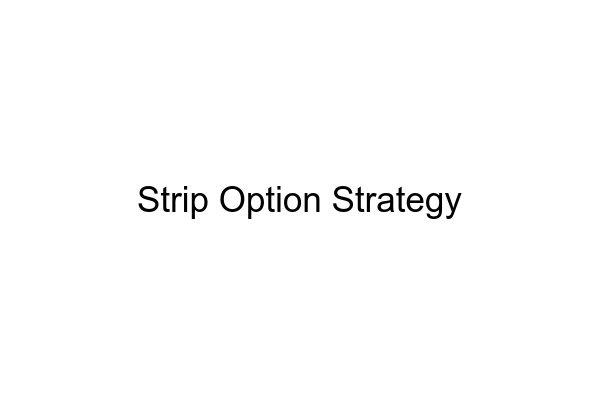Strip Option Strategy

What are the characteristics of this option strategy?
The Strip option strategy is an advanced options trading strategy that involves buying one long call and two put option positions in the same asset and expiry month. This strategy can be used either as a bullish, bearish or neutral strategy.
Is this a bullish, bearish or neutral strategy?
The Strip option strategy can be used as either a bullish, bearish or neutral strategy depending on the position taken by the investor. For example, a Strip option strategy can be structured as a bearish strategy by buying two put and one calls. On the other hand, it can also be used as a bullish strategy while buying two calls and one put.
Is this a beginner or an advanced option strategy?
The Strip option strategy is an advanced options trading strategy and is rarely recommended to beginners. This option strategy involves several risks and investors should be well versed in options trading before implementing this strategy.
In what situation will I use this strategy?
The Strip option strategy is used when you have a short-term belief about the magnitude of the underlying asset’s price, but you don’t have a strong conviction about direction of the move. This strategy is typically used during a high volatility environment where a large move in share price is expected.
Where does this strategy typically fall in the range of risk-reward and probability of profit?
The strap option strategy can have a high probability of profit, but it requires high upfront payment. The trader will have to pay more in commissions and fees, and loose all of it if the trade does not go as planned.
How is this strategy affected by the greeks?
The greeks – delta, gamma and vega – play a major role in determining the risk-reward profile of a Strip option strategy. Since this strategy involves two option positions on the same underlying, optio values of all three greeks affect the profitability of the strategy. Delta acts as the primary driver of the strategy’s profitability; so understanding the relationship between delta and other greeks is important for successful implementation of this strategy.
In what volatility regime (i.e VIX level) would this strategy be optimal?
This strategy is typically most optimal when volatility is high, indicating huge upmove in either direction. However higher volatility increases the upfront premium to be paid to execute the strategy.
How do I adjust this strategy when the trade goes against me? And how easy or difficult is this strategy to adjust?
Adjusting this strategy when the trade goes against you can be difficult, due to the fact that it involves trading multiple option contracts. It is also worth noting that when adjusting the strategy, the trader must be aware of any changes in the greeks which might affect the price of the strategy.
Where does this strategy typically fall in the range of commissions and fees?
Due to the fact that this strategy involves trading multiple options contracts, the commissions and fees associated with the strategy will likely be higher than other option strategies. However, the specific commission and fee rates depend on the broker being used.
Is this a good option income strategy?
This is not an ideal strategy to generate a steady flow of income over time as it is a net debit strategy. This strategy can be used to capture large movements in share price, without purchasing the stock. However, it is important to note that because this strategy involves trading multiple options, it carries a high degree of risk.
How do I know when to exit this strategy?
When deciding when to exit this strategy it is important to consider the position’s potential risk and reward as well as the expected return on investment. An investor should consider exiting the position if the potential reward is uncomfortably low or if the underlying asset moves significantly in either direction.
How will market makers respond to this trade being opened?
Market makers typically try to take a neutral stance when responding to trades that are opened, and will try to match the buyer and seller of options. However, they will adjust their prices as they see fit in order to remain profitable.
What is an example (with calculations) of this strategy?
For example, an investor enters into a Strip option strategy on MSFT stock with an underlying stock price of $277.50. They buy one ATM call option and two ATM put options. The net premiums to be paid for these options is $1485. If the underlying stock price remains above $295 at expiration, the investor can potentially end up with unlimited net profit. If the underlying stock price rremains below $270, the investor unlimited net profit.
MarketXLS is an advanced options trading platform that can help investors easily analyze and implement options strategies such as the Strip option strategy. It has a suite of tools specifically designed for options analysis, market analysis and risk management. These tools help investors easily identify market trends and adjust their strategies quickly when necessary.
Here are some templates that you can use to create your own models
Strip Strangle
Strip Straddle
Strap Straddle
Strap Strangle
Search for all Templates here: https://marketxls.com/templates/
Relevant blogs that you can read to learn more about the topic
Becoming a Pro by Knowing the Option Delta Formula
Understand What a Strangle in Options Is
Strip Straddle Options Strategy (Using MarketXLS Template)
Strap Strangle Options Strategy (Using MarketXLS Template)
Strip Strangle Options Strategy (Using MarketXLS Template)
